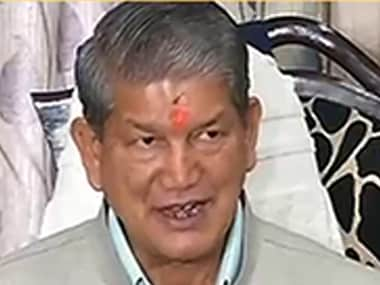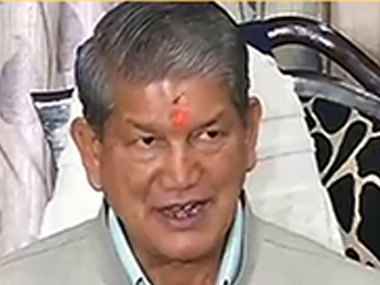The order by a division bench of the Uttarakhand High Court staying the floor test has set the stage for a second round of legal battle, the course of which would depend upon the material submitted by the Centre, justifying imposition of President’s Rule in the state. The single judge order directing a floor test — against which the Centre had approached the division bench presided over by the Chief Justice of the High Court — was passed without formally taking on record the Centre’s stand on the matter and the report(s) of the Governor that formed the basis for the imposition of the Central Rule. According to reports, the Centre has agreed to file an affidavit by Monday to which ousted Chief Minister Harish Rawat will respond to by the following day, ensuring that the affidavits with the stand of both sides are on record before the court takes up the matter for the next hearing on 6 April. The Chief Justice’s bench, which heard Centre’s plea against the earlier order, is expected to have on record the report(s) by the Governor which is likely to be submitted by the Centre along with its affidavit. With the controversy centered around numbers in the House, the single bench, in its interim order, had directed Rawat to take a trust vote on 31 March. [caption id=“attachment_2705570” align=“alignleft” width=“380”]
 Harish Rawat. Screengrab[/caption] Though a floor test cannot be ruled out, the hearing before the Chief Justice’s bench could take a new direction if the Centre relies heavily on horse-trading, violation of rules by the Speaker or other grounds to justify the breakdown of constitutional machinery. The arguments, in such a circumstance, are likely to Centre around whether it was permissible under the Constitution to remove an elected government in the circumstances highlighted in the report(s) by the Governor. The court could come to a finding on the validity of the President’s Rule after considering the facts in the light of Article 356 of the Constitution, which says that, ‘In the event that a State government is not able to function as per the Constitution, the State comes under the direct control of the central government’. Though the Chief Justice’s bench has stayed the floor test for now, it could take the same decision if it concludes that the reason for imposition of the Central rule was the inference that Rawat had lost support of the majority. Questioning the order directing a floor test Mukul Rohatgi, the Attorney General of India, argued before the Chief Justice’s bench on Wednesday that the order of floor test by the single judge amounted to suspending Presidential proclamation and that no purpose would be served by a floor test as there was no government in place. Though the argument may seem convincing, the single judge had, however, reportedly made it clear that he was not suspending the President’s Rule. So, while Rohatgi may have referred to Rawat going out or continuing as Chief Minister when he stressed that the floor test would not serve any purpose, the order may not have been aimed at that argument. It may be wrong to consider the floor test, as directed by the single judge in this case, to be a proceeding of the House as the voting was reportedly ordered to be conducted under the supervision of the Registrar General of the High Court. The process might have only helped the court in taking a decision on the validity of the proclamation. The court can always set a wrong right. It can order a fresh floor test if it was wrongly denied. But here was a case of an interim order which may have been aimed at testing the basis on which the President’s Rule was imposed. Rawat should have supported it on Wednesday, and should support it during subsequent arguments. If he has enjoyed majority, then the Governor’s report may have been misleading on this aspect. The Supreme Court, in the SR Bommai case of 1994, had held that in case of a challenge, it was “necessary” for the court to scrutinize the material on the basis of which the decision to impose President’s Rule was taken. “This can be done by the courts while confining themselves to the acknowledged parameters of the judicial review as discussed above, viz., illegality, irrationality and mala fides. Such scrutiny of the material will also be within the judicially discoverable and manageable standards,” the Bommai judgment said, while talking about scrutiny. True, there is probably no such case in which the court has ventured on the ground to conduct scrutiny. But, there can always be a first. Those opposing it need to give valid reasons against it.
Harish Rawat. Screengrab[/caption] Though a floor test cannot be ruled out, the hearing before the Chief Justice’s bench could take a new direction if the Centre relies heavily on horse-trading, violation of rules by the Speaker or other grounds to justify the breakdown of constitutional machinery. The arguments, in such a circumstance, are likely to Centre around whether it was permissible under the Constitution to remove an elected government in the circumstances highlighted in the report(s) by the Governor. The court could come to a finding on the validity of the President’s Rule after considering the facts in the light of Article 356 of the Constitution, which says that, ‘In the event that a State government is not able to function as per the Constitution, the State comes under the direct control of the central government’. Though the Chief Justice’s bench has stayed the floor test for now, it could take the same decision if it concludes that the reason for imposition of the Central rule was the inference that Rawat had lost support of the majority. Questioning the order directing a floor test Mukul Rohatgi, the Attorney General of India, argued before the Chief Justice’s bench on Wednesday that the order of floor test by the single judge amounted to suspending Presidential proclamation and that no purpose would be served by a floor test as there was no government in place. Though the argument may seem convincing, the single judge had, however, reportedly made it clear that he was not suspending the President’s Rule. So, while Rohatgi may have referred to Rawat going out or continuing as Chief Minister when he stressed that the floor test would not serve any purpose, the order may not have been aimed at that argument. It may be wrong to consider the floor test, as directed by the single judge in this case, to be a proceeding of the House as the voting was reportedly ordered to be conducted under the supervision of the Registrar General of the High Court. The process might have only helped the court in taking a decision on the validity of the proclamation. The court can always set a wrong right. It can order a fresh floor test if it was wrongly denied. But here was a case of an interim order which may have been aimed at testing the basis on which the President’s Rule was imposed. Rawat should have supported it on Wednesday, and should support it during subsequent arguments. If he has enjoyed majority, then the Governor’s report may have been misleading on this aspect. The Supreme Court, in the SR Bommai case of 1994, had held that in case of a challenge, it was “necessary” for the court to scrutinize the material on the basis of which the decision to impose President’s Rule was taken. “This can be done by the courts while confining themselves to the acknowledged parameters of the judicial review as discussed above, viz., illegality, irrationality and mala fides. Such scrutiny of the material will also be within the judicially discoverable and manageable standards,” the Bommai judgment said, while talking about scrutiny. True, there is probably no such case in which the court has ventured on the ground to conduct scrutiny. But, there can always be a first. Those opposing it need to give valid reasons against it.
Uttarakhand crisis: Round II could take new course for Rawat but floor test should not be ruled out
Gyanant Singh
• March 31, 2016, 16:00:14 IST
According to reports, the Centre has agreed to file an affidavit by Monday to which ousted Chief Minister Harish Rawat will respond to by the following day, ensuring that the affidavits with the stand of both sides are on record before the court takes up the matter for the next hearing on 6 April.
Advertisement
)
End of Article